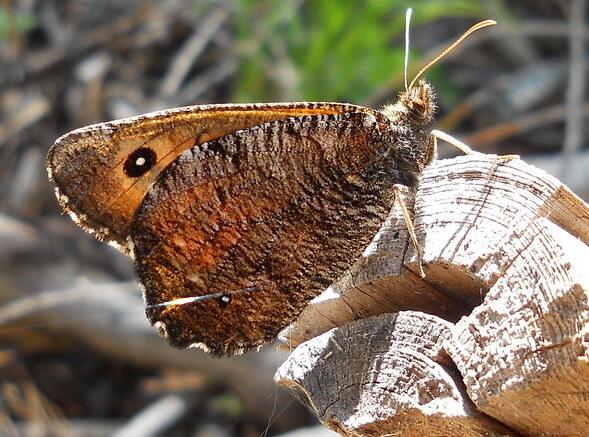Low-
Moderate
The population of the great arctic gigas subspecies in Washington is critical and the trend is unknown. If this butterfly persists in Washington, population sizes are likely small. A Pacific Northwest endemic, this butterfly has been found on a single site within the United States, in northwestern Washington; it also occurs in southwestern British Columbia and may occur on other sites with similar habitat. It is a "Species of Greatest Conservation Need" due to its restricted range, distribution, and habitat, and many threats to its grassland-forest edge habitat.
Description and Range
Physical description
The great arctic, a member of the Satyr (Satyrinae) butterfly subfamily, is a large tawny brown butterfly with a bark-like patterned ventral hindwing, such that when perched they are quite camouflaged. Wingspan is up to 2.5 inches.
Ecology and life history
Great arctic belongs to a group of butterflies, the arctics and alpines, that inhabit far northern and alpine climes. The great arctic inhabits forest openings, meadow edges, and rocky slopes and outcrops from sea level to mid-elevations. Aside from dependence on specific but unknown grasses and forest edge ecotone, little is known of their habitat requirements.
The life history of great artic is not well known. One unusual aspect of their life history is a life cycle, from egg to adult that spans two years.
Adults are present in June and July, and females lay eggs on unknown species of grasses where larvae develop over two years; the timing and location of larval and pupal stages are unknown. This two-year life cycle is synchronized amongst individuals and results in adults mostly occurring in even-numbered years.
Males exhibit territorial flight behaviors of perching and patrolling, and are known to congregate on ridges and hilltops, a behavior called “hilltopping”. This butterfly’s habits of jerky flights through open forest and perching on trees where they are concealed makes them difficult to detect.
Geographic range
The great arctic gigas subspecies occurs in British Columbia, primarily on Vancouver Island, with a few sites in the mainland Coast Range, and a single site known from Washington, on Orcas Island (San Juan County) in the northwestern portion of the state. Recent efforts to relocate great arctic on Orcas Island have been inconclusive; WDFW surveyors had fleeting observations of unidentified but similar looking butterflies, and they located additional potential habitat for future survey. If this butterfly persists in Washington, population sizes are likely small.
For a map of range-wide distribution and conservation status of the great Arctic butterfly species, check out NatureServe Explorer.
Climate vulnerability
Sensitivity to climate change
Low-
Moderate
There is no information regarding the sensitivity of this species to climate change, and very little known regarding its life history. As an occupant of forest openings and meadow edges, it may benefit from more frequent fire which contributes to the creation of these habitat characteristics. However, larvae are thought to develop on grasses, and could be killed by fire. Small population sizes and limited distribution in Washington make it vulnerable to extirpation.
Exposure to climate change
Low-
Moderate
- Altered fire regimes
Conservation
Conservation Threats and Actions Needed
- Resource information collection needs
- Threat: Current status and distribution in Washington is unknown.
- Action Needed: Survey historic locale and other potential sites.
- Invasive and other problematic species
- Threat: Forest encroachment due to long-term fire suppression has reduced amount and quality of habitat. Host plant is a grass, and this butterfly utilizes open forest and forest edge.
- Action Needed: Survey historic locale and other potential sites.
See the Climate vulnerability section above for more information about the threat posed by climate change to this species.
Resources
References
Dornfeld, E. J. 1980. Butterflies of Oregon. Timber Press, Forest Grove, Oregon. 276 pp.
Guppy, C. and J. Shepard. 2001. Butterflies of British Columbia: including Western Alberta, Southern Yukon, The Alaska Panhandle, Washington, Northern Oregon, Northern Idaho, and Northwestern Montana. University of British Columbia Press, Vancouver, B.C.
Pyle, R. 1989. Washington butterfly conservation status plan. WDFW. Olympia. 216 pp.
Pyle, R.M. and LaBar, C.C. 2018. Butterflies of the Pacific Northwest. Timber Press. 461 pp.
WDFW publications
Other resources
